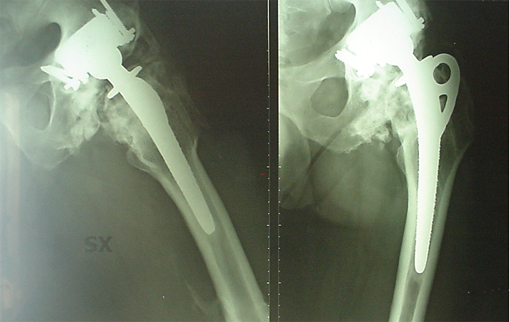|
Antonio
Croce *
,Marco Ometti *,Paolo Ferrua*,Walter Albisetti**
* Sport Traumatology Center, I Division, Gaetano Pini Orthopaedic
Institute, University of Milan, Place A. Ferrari, 1 Milan
** Pediatric Orthopaedic Center, VI Division, Gaetano Pini
Orthopaedic Institute, University of Milan, Place A. Ferrari, 1
Milan.
Address for Correspondence:
Marco
Ometti, MD
Sport Traumatology Center, I Division
Gaetano Pini Orthopaedic Institute
Place A. Ferrari, 1
20126, Milan
ITALY
|
|
Abstract:
In
this case report, a 60-years-old man is presented who had been
operated on because of a osteoarthritis secondary to a femoral
neck fracture in 1977. The interesting aspect of this case is
that left hip was replaced with Judet type prosthesis, which
survived for 30 years. This is one of the few prostheses which
have not failed to stand the test of time and may still be
encountered.
J.Orthopaedics 2008;5(1)e5
Keywords:
hip
prosthesis; Judet; osteoarthritis
Introduction:
In
September, 1971, the problem of loosening of methylmethacrylate
cemented total hip arthroplasties moved Judet group to develop
and study a model of a press fit total hip prosthesis without
cement. The main objective of this prosthesis was to obtain a
kind of alveolate and porous surface, whith cavities between 200
microns and 2 mm broad and about 1-2 mm deep, so that new formed
bone fillig these cavities could be thick and strong enough to
resist the pressure and stresses to which it could be submitted.
The metal used was a cobat chrome molybdenum nickel alloy; the
prosthesis was cast following a special procedure which produced
the alveolate and porous surface.
The
prosthesis was composed of 2 components. The femoral stem had a
quadriangular section which was strong at the top and thinner
towards the inferior end. A fenestrated trapezoidal fin was
attached to the stem which was implanted in the trochanter. A
flat collar sat around the stem above the trapezoidal fin. The
articular component had an articular socket made of High Density
Polyethylene (H.D.P.) contained in a cup made of alveolate and
porous metal. The polyethylene could be replaced without
removing the cup.
Case
Report :
We
report a case of a man aged 60 who,
in 1970, was involved in a car accident after which he reported
fractures of the left femoral neck and left femoral diaphisis;
he had undergone a operation of reduction and synthesis with
intramedullary nail. After 7 years he developed a secondary
osteoarthritis and in December 1977 he had hip arthroplasty.
Left hip was replaced with Judet type prosthesis, CoCr
head Æ
28 mm, medium neck and a cementless and screw-fixed cylindrical
socket (Judet Special Cup) Æ
52 mm with an interchangeable PE insert (Fig. 1).

Fig.1:
Radiographic control of the Judet cementless hip prosthesis
Since
that time he had had no trouble with his hip. We have seen him
in our Institute (G. Pini, Milan) in September 2007 for a
medical inspection. On examination he had 70° of hip flexion
with 10° of abduction, internal and external rotation. All
movements were pain free.
Discussion :
Other very long-term results of hip replacement are rare. Joshi et al (1993)
reported the 24-years survival of a Charnley-type prosthesis and
Zaoussis and Patikas (1989) reported two McKee-type implants
still insitu after 20 years. In fact, in the long search for
effective hip arthroplasty, few prostheses have not failed to
stand the test of time. One such is the Judet prosthesis, which
may still be encountered.
Reference :
-
Tennent
TDEastwood MB. Survival
of the Judet hip prosthesis;. J R
Soc Med 1998;91:385-386
-
Tatari
H, Alici E, Havitçio H.
Forty-two year survival with bilateral
Judet hip prostheses; Arch Orthop Trauma Surg [0936-8051]
2001;121(1-2) Pages: 112-3.
-
Judet
T, Judet H. A collection of portraits of Judet
Prosthesis; Maîtrise Orthopédique n° 2, January
1991.
-
Joshi
AB, Porter ML. Long-term results of Chranley low-friction arthroplasty in young
patients; J Bone J Surg (Br), 75-B:616-23.
-
Zaoussis
AL, Patikas AF.
Experience with total hip arthroplasty in Oreece, the first
20 years:
a particular reference to long-term results with the
McKee-Farrar technique.
Clin Orthop
1989;
246:39-47.
-
Judet R, Siguier M, Brumpt B, Judet T. A
non-cemented total hip arthroplasty; Clinical
Orthopaedics and Related Research, 137: 76-84,
November-December 1978.
|



